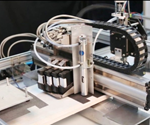Marshall Aerospace and Defence 3D-prints aerospace parts
The company is using Stratasys 3D printers for prototype and production parts using composites and other advanced materials.
Marshall Aerospace and Defence Group (Cambridge, U.K.) is using advanced 3D printing from Stratasys (Eden Prairie, Minn., U.S.) to manufacture flight-ready parts using composites and other advanced materials for several of its military, civil and business aircraft.
Marshall says that it already has several pieces of 3D-printed ductwork flying on heavily modified aircraft, as well as holders for safety knives and switches for aircraft interiors. According to the company, 3D printing flight-approved parts on demand enables production of lighter parts than using traditional methods, significantly faster and at lower cost.
According to Chris Botting, materials, processes and additive manufacturing engineer at Marshall ADG, the ability to create accurate, repeatable and reliable 3D printed parts using aerospace-approved materials are key factors in achieving the performance requirements necessary for use within aircraft.
“When manufacturing on complex engineering programs, we need a method that can create an accurate, complex, functional and lightweight duct efficiently with minimal tooling costs — this is where 3D printing fits perfectly,” Botting says. “But we also need to ensure that the ducting work produced will be approved by the EASA for flight. As a result, we’re using the Stratasys Fortus 450mc FDM Printer and ULTEM 9085 resin — a tough, yet lightweight 3D printing material with high thermal and chemical resistance. This has been crucial to overcoming the stringent requirements of our industry, as we can now 3D-print parts with the desired flame, smoke and toxicity properties for use on aircraft interiors.”
The company is also utilizing its Fortus 450mc 3D printer, purchased from Stratasys UK and Ireland Platinum Partner SYS Systems, to build final parts on the ground. Marshall recently created a ducting adapter prototype for vital ground-running equipment essential for providing fresh air to cool the aircraft’s avionics. 3D printing this particular part helped Marshall transition from typically costly aluminum processes, the company says.
“Before committing to expensive aluminum machining, we used the Fortus 450mc to 3D print a prototype in ASA material,” says Botting. “It enabled us to create an accurate working prototype of a complex component. We were then able to demonstrate it had the potential to be 3D printed in Nylon 12 material as opposed to the more conventional method of machining from aluminum. The 3D printed duct led to a significant cost reduction compared to machining the part out of aluminum, as well as a 63% reduction in overall weight.”
The group is also using Stratasys 3D printers for a range of complex tooling applications, including drill jigs, masking templates, bonded fixtures and composite mold tooling. The team regularly produces customized, low-volume production tools within 24 hours of an engineer’s request. In fact, the company says it is driving use of 3D-printed thermoplastic tools to replace heavy metal tools, which it says will reduce the burden on the operator, as well as reduce cost and lead times on urgent operational tasks.
Related Content
-
US Air Force selects Integris Composites ballistic body armor
Cratus Wave armor is thin, lightweight and reduces heat stress, providing buoyant personal protection for the 582nd Helicopter Group.
-
Airbus presents unmanned Wingman concept
Fighter jet model unveiled at ILA Berlin, made from an iron structure and composite outer skin, will deliver more tactical options, supporting future combat missions.
-
Large-format 3D printing enables toolless, rapid production for AUVs
Dive Technologies started by 3D printing prototypes of its composite autonomous underwater vehicles, but AM became the solution for customizable, toolless production.

.jpg;width=70;height=70;mode=crop)














